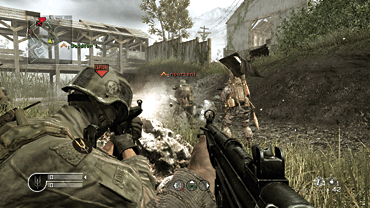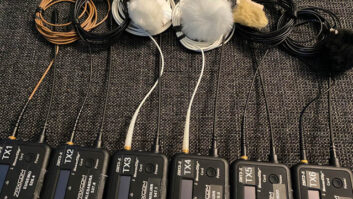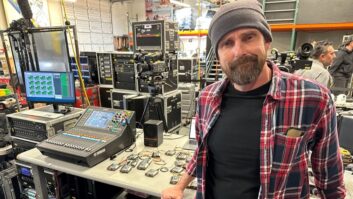

In 2004, game developer Infinity Ward released Call of Duty (CoD) to much critical acclaim, and the title soon became the benchmark World War II first-person shooter (FPS) game. Published by Activision, CoD immerses the player in a cinematic experience with exciting missions and intense battles amidst one of history’s most epic chapters. Earlier this year, Infinity Ward released the fourth installment of its extremely successful franchise, Call of Duty 4: Modern Warfare (CoD 4), which continues to dominate the FPS genre. In addition, CoD 4 taps into next-generation platform technology and is available for PC, PlayStation 3 and Xbox 360.
CoD 4 is the first game in the series that is not based in the WWII era; it is primarily set in modern-day combat scenarios of black ops. The game gives the player the ability to star in several interactive roles, including a role in Britain’s elite SAS special forces, as a member of the U.S. Marine Corps 1st Force Recon and as a gunner on an AC-130 Spectre Gunship. The player is key to neutralizing the ability of rogue separatists to launch nuclear warheads.
Needless to say, the audio production for CoD 4 was a monumental undertaking, but in the hands of the veterans of the Infinity Ward audio team (based in Encino, Calif.), no challenge was too great.
CAPTURING THE SOUND OF WAR
The audio team faced a major challenge in capturing the sounds of weapons for CoD 4, not just in the actual recording, but in the logistics of finding the heavy-duty firepower needed to provide the necessary realism. According to Mark Ganus, audio lead at Infinity Ward, “We were fortunate to gain access to various military bases here in Southern California for a variety of vehicle and live-fire field recordings.” This access included various weapons, specifically live-fire training at various bases, M1A1 Abrams tank exercises at Twentynine Palms, CH-46 Sea Knight helicopters at Miramar. According to Ganus, the team spent “nearly…an entire day at Camp Pendleton to record an AH-1 Cobra helicopter.”
When it came time to record small arms, the team held two recording sessions: one in Nevada and another along the California/Mexico border. “Everything we needed to support the change from World War II weapons to modern-day was used,” Ganus says, “such as AK-47, M249 SAW, MP5 and MP5SD. We used a variety of recorders for our shoots, [which were] chosen for their different-sounding preamps, including the Sound Devices 744, which was more clinical and precise sounding. The Fostex FR-2 was also used, in addition to an [analog] Nagra because there is just no replacement for tape saturation. We like the [FR-2’s] preamp for its warm and full sound, its ease of use and for the ability to copy the data over from the cards instead of streaming off of a DAT.”
According to Ganus, the team used a variety of microphones with the different recorders; models included Sennheiser lavaliers and the MD-421, Audio-Technica AT822 stereo mic, Neumann RSM191 stereo shotgun mic and KMR81, DPA 4007, AKG D-112 and many others.
The original score for CoD 4 was composed and arranged by veteran film composers Harry Gregson-Williams and Stephen Barton. Music spotting was done by the Infinity Ward team, which provided the composers with video of specific scenes that were chosen for their emotional significance. Ethnic instruments provide an authentic flavor to the various locales where certain events unfold, including the Middle East and various parts of Eastern Europe. In addition, a modern guitar gives the mission a heroic sense as the player comes to the aid of his fellow soldiers. The score was recorded at Air Lyndhurst and Abbey Road Studios in London, and then mixed at Gregson-Williams’ Southern California studio.
THE CRIES OF BATTLE
The most powerful (and obvious) way to tell a story is, of course, through dialog. But in a military shooter, there are key game cues that are also delivered through dialog. According to dialog editor Chrissy Arya, there were challenges associated with the casting of voice-over talent, primarily with foreign-language actors. “It was difficult to find quality actors here in Southern California who could fluently speak and read Arabic and Russian,” she says. “We even went abroad to the UK to record a couple of our key British voice actors.” The language challenges prompted the team to “use phonetic translations for the editors and voice-over directors to follow what was being said.
“We wanted the recordings to feel natural on our battlefield in the game,” Arya continues. “We leaned very heavily on our performers to deliver their lines with battle-like intensity.”
The audio team at Infinity Ward took in-game radio communication to a whole new level by providing templates for 11 different types of radio processing. “We did this to help deliver realism to the player by providing an aural difference when communicating with other soldiers who were in tanks, helicopters, flying in an AC-130 or even under heavy fire in another area of the game,” says Arya.
AUDIO IMPLEMENTATION
CoD 4 introduces a few technical firsts for Infinity Ward’s team. According to sound designer Stephen Miller, the number of 3-D sound emitters was vastly increased to provide a heightened sense of realism for the player. “Everything — from a large variety of creaks and groans, to simple things like flies and crickets — was added to help further immerse the player into the environment,” Miller says The game also introduces 4-channel ambient streams from disk, which, according to Miller, feature “dynamic switching of different battle ambiences based on the amount of action going on in the game.” Audio effects include real-time filtering based on line of sight; essentially, every 3-D sound emitter’s line of sight relative to the player is checked by the game engine, with filtering applied accordingly.
Signature game sounds received special consideration. “A lot of attention was placed on trying to replicate the power we experienced from the Abrams’ [M1A1 tank] main canon,” explains Miller. “Each single shot is actually broken down into four separate components: The first two are the 3-D positional crack and boom of the initial part of the sound. The next part is the 3-D positional tail or decay. The fourth part is a stereo sweetener that envelops the player, playing out of both the front-left and -right speakers, but also the surround speakers.” This sound is further modified based on the player’s proximity to the effect, says Miller. “If the player is too close to the tank when it fires, this action will trigger a real-time mix change, deadening the surrounding chaos and initiating a realistic ringing of the ears.”
The audio team applied this tiered approach to explosions and other regular sonic elements in the game. “We didn’t want to have just a single canned sound with a couple of variations, so we decided to take it much further,” says Miller. “Additional sounds were also placed on headlights, windows and tires, which are also triggered during an explosion. We made use of our physics engine to attach sounds to the car hood and doors, so after the explosion the falling debris impacts the ground or other objects nearby, triggering the correct sound. Everything works together so that the explosion never feels out of place — it never sounds exactly the same way twice.”
Instead of providing a continuous soundtrack, the game’s music judiciously emphasizes dramatic moments, changing dynamically based on what’s happening onscreen. Ganus mentions one piece in particular: “Launch Facility B,” which “dynamically changes through five different versions of the music piece to coincide with the clock timer counting down, giving the player an aural sense of urgency and to help compel the player forward through the mission.”
All of the implementation for CoD 4 was done through the use of proprietary tools integrated within a level editor that allows a sound designer to place sound emitters graphically into the world and edit their properties easily.
MIXING FOR THE PLAYER PERSPECTIVE
Ganus notes that in mixing CoD 4, the audio team wanted to give the player the sense that he or she is influencing the action rather than merely observing it. “The player’s weapon sounds are in the foreground [of the mix] and immediacy is given to nearby whiz-by, bullet impact and explosion sound effects, connecting the player to the danger of the situation,” he explains.
Given the sheer amount of music, dialog and sound effects produced for CoD 4, the team at Infinity Ward had to implement a sophisticated mixing system to address the inherent complexities of such a large amount of in-game audio playback. The team relied on the proprietary sound engine’s ability to allow an individual sound effect to dynamically influence the sound mix, as sound designer Miller explains: “When the player steadies his weapon and holds his breath [in sniper mode], the sound engine ducks any extraneous sound effects, giving more focus to the sound of the player’s heartbeat while retaining any current musical intensity.” As another example, when a player is in close proximity to a flash-bang grenade blast, a “ringing-in-the-ear” sound effect is triggered as all other sounds duck out for a brief moment of time, simulating the effect of being temporarily deafened by a grenade’s sonic blast.
The team also enhanced the sound engine’s bus architecture. “We increased the number of mixing buses from CoD 2 to CoD 4 to provide a higher degree of manipulation,” says Ganus. “We also added more user-definable bus attributes, giving us control and flexibility not previously available.”
The center channel was used to emphasize key dialog and sound effects rather than for sound positioning, Ganus explains. “This decision was based on the fact that sound can be placed in a full 360-degree perspective without the use of the center channel, and to account for individual consumer taste in setup and calibration of this channel that can skew the intended 3-D positioning.”
A SOUND COMMITMENT
Because audio is such an integral part of Infinity Ward’s game production, the company invested in the development of two Dolby-calibrated 5.1 sound design suites, in addition to two dialog editing rooms and a multipurpose Foley/recording room.
Throughout the project, three programmers ensured that working with the three individual platforms — PC, PlayStation 3 and Xbox 360 — was as transparent as possible. This allowed the audio team at Infinity Ward to focus on the game’s audio design rather than worry about individual platform idiosyncrasies. According to Ganus, “This was the first time Infinity Ward has done a three-sku simultaneous release and the second game in a row [for Infinity Ward] to tool up for a new platform — CoD 2 was new on the 360, CoD 4 is new on PlayStation 3.”
Call of Duty 4: Modern Warfare has received an incredible amount of praise, not only for providing spectacular photo-realistic graphics, but also for achieving one of the best audio experiences available today for any first-person shooter videogame currently on the market. The Infinity Ward audio team has proved yet again that videogames have truly reached the audio production scale and sophistication of film.
Michel Henein couldn’t be reached for several days after this assignment — something to do with research for this article.
“CoD 4” By the Numbers
THE INFINITY TEAM SHARES THE “REAL” GAME SPECS
3: number of G5 Macs killed
6: number of translated languages
14: number of recorded perspectives on each weapon fire
36: number of profanities recorded on the first Abrams’ main cannon fire (prefaced by the words “oh, sh*t”)
170: number of hours spent recording voice-over
1,500: number of caffeinated beverages consumed during the project (per person)
10,000: number of uniquely referenced sound effects
750,000: number of individual sound parameters used to define the game








